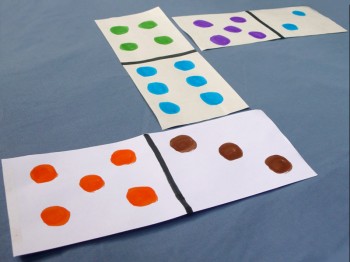Lesson Plans for Elementary School Students
Math Lesson Plan: Domino Adding
 A fun way to practise adding numbers to 12. Using the familiar picture patterns of dominoes, students match ends of two paper dominoes, saying “3 plus 6 equals 9”. Teacher models reusing photocopy paper, cutting sheets in half lengthwise (hot dog way) beforehand. Students can fold them in half, drawing a black marker line on the fold, then using domino examples to make number patterns with bingo dabbers on each side of the domino (numbers 0 to 6). Students love making and playing this game. ** Older students could simply print double digit numbers on each end, adding or subtracting them in their heads as their game.
A fun way to practise adding numbers to 12. Using the familiar picture patterns of dominoes, students match ends of two paper dominoes, saying “3 plus 6 equals 9”. Teacher models reusing photocopy paper, cutting sheets in half lengthwise (hot dog way) beforehand. Students can fold them in half, drawing a black marker line on the fold, then using domino examples to make number patterns with bingo dabbers on each side of the domino (numbers 0 to 6). Students love making and playing this game. ** Older students could simply print double digit numbers on each end, adding or subtracting them in their heads as their game.
Objectives:
- Adding practise to 12
- Learning picture patterns for quick number identification
- Practise for adding doubles
- Modelling reuse of paper (3 R’s)
Materials:
- Scrap photocopy paper, reuse other side to make dominoes – cut in half lengthwise, divide in half by drawing a black line, then bingo dabbing numbers 6 or under on each side, making it look like a paper domino (**students can make these if you show them the familiar picture pattern of dots/numbers on dominoes, eg. how numbers 1-6 are placed on dominoes)
- bingo dabber and black marker
- scissors
- (if possible, but not necessary) real dominoes
Method:
- Show students real dominoes, or draw pictures of number representations with dots on board (highest is 6, have blank sides too). Then show them how to make paper dominoes, which we’ll use to add (either matching and adding doubles, or adding 2 different numbers). Fold paper like a hot dog, lengthwise, then cut on the fold. Divide in half by marking a line dividing it in two, with a black marker. Each side will have dots dabbed on them with bingo dabbers, like real dominoes. Students need to be careful to copy the patterns for 6, 5, 4, 3 so that it will be easy to recognize these numbers. If every student makes 5 sheets of dominoes, they will have 10 dominoes each and 20 with a partner, enough to play. After a short play time, one group can trade dominoes with another for a change of dominoes.
- Show students how to put the ends of two dominoes together and total the amount of dots. Tell students they can add up the dots, but try to remember what 6 looks like or 5 looks like, so that they can add them together faster. Dominoes in play can form any shape they want.
- Depending on which game you are playing, either tell students to match doubles (5 + 5 or 3 + 3 or 6+ 6), or to put any two numbers together and add them. Students learn to recognize number patterns, those dots show 3, those dots show 6, that’s a group of 5, etc., they get to practise adding up to 12 in a fun game, plus get practise adding doubles together (5+5 is 10, 4+4 is 8 etc.).
- Students can play with partners anywhere in the room. (The first student puts 2 dominoes together, saying “3 plus 6 equals 9”. The next student puts another domino beside the 6, saying “6 plus 5 equals 11”. The next one will be “5 plus something…)
- Dominoes can later be put into learning centers to be played solo during free time, or taken home for counting practise, then returned to the centers. **When no longer needed, students may keep a set and take home for reviewing.
Tags: adding, adding doubles, grade 1, grade 2, number patterns, picture patterns, reuse
